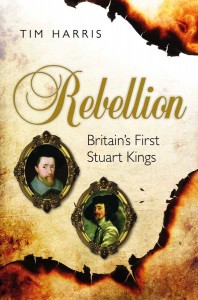Rebellion: Britain’s first Stuart kings, 1567–1642
Published in Book Reviews, Issue 6 (November/December 2014), Reviews, Volume 22Tim Harris
Oxford University Press
£30
ISBN 9780199209002
This book is an ambitious attempt to investigate the problems faced by the Stuart monarchs of Britain and Ireland in the early seventeenth century. After James VI of Scotland succeeded Elizabeth I of England, the Stuarts became rulers of multiple kingdoms that had different political, religious and social structures. Inherently fraught with tension, by 1642 all three kingdoms of England, Ireland and Scotland had rebelled against Stuart rule. Thus the central goal of the book is ‘to explain why this multiple monarchy . . . did not prove robust enough to withstand the various crises that it faced in the early seventeenth century’ (p. 497).
Any attempt at a history of the three kingdoms is beset with difficulties. How does one integrate events from the three kingdoms into a coherent narrative? Austin Woolrych, when faced with this problem, declared that ‘sheer intelligibility commands a closer focus on England’. In Rebellion most of the chapters are dedicated to events in England, but Harris engages with events in Ireland and Scotland in a meaningful way. Chapter 6 provides an excellent discussion on the challenges posed by religious divisions in Ireland, which includes a brief discussion on the influences of Catholic Europe on Irish Catholic identities. This is complemented by an analysis of James I’s attempts to reform the Church of Scotland; he hoped to align church practice and government with that of England. Harris concludes that both Ireland and Scotland were at relative peace by the end of his reign but suggests that these Jacobean successes were ultimately short-lived and precipitated many of the problems later faced by Charles I.
Harris is keen to illustrate the processes that shaped James I’s and Charles I’s actions and is quick to point out their rationale for making decisions. Take, for example, Charles I’s ‘Personal Rule’ in the 1630s, whereby he refused to call an English parliament, having had his fingers burned by the 1629 session (pp 268–78). Many of the king’s contemporaries accused him of being a tyrant. This became a key point for those who rallied behind the parliamentarian banner in the lead-up to, and the outbreak of, the English Civil War. Yet Harris argues that from a strictly legal perspective Charles acted within the law (although admittedly the author does include the proviso that the ‘law can always be argued’). Furthermore, Harris maintains that Charles ‘was no autocrat’ (p. 284); he willingly sought the advice of others, even promoting those who had previously opposed him, most notably Sir Thomas Wentworth, who became lord president of the north in 1628 and lord deputy of Ireland in 1632. On the basis of this evidence, one might assume that Harris sides with historians who do not believe that Charles I is predominantly to blame for the Wars of the Three Kingdoms. It is not so simplistic, however. Yes, ‘Charles . . . proved not to be up to the job’, but, as Harris skilfully shows, ‘we have to look at what was going on in society more broadly . . . focusing on the personality of the man in charge is important, but [is] only one part of the story’ (p. 498). Similarly, when discussing whether religious tensions caused the wars of the 1640s, Harris details how Stuart reforms of the church in England and Scotland and sectarian differences in Ireland exacerbated tensions across the three kingdoms and argues that ‘major political and constitutional sources of conflict’ were also involved (p. 504).
Another strength of this work is Harris’s ability to integrate events that occurred within the higher political echelons with wider social developments. It is understandable in a synthesis such as this that much of what is discussed would be well known to specialists, yet Harris draws upon new ex-amples and opens up new avenues for exploration. His discussion on the emergence of ‘public opinion’ in the 1620s and 1630s helps to establish the context for what is without doubt one of the most valuable parts of this work, his chapter on why some English people became royalists and others became parliamentarians (Chapter 15, ‘The Rise of Royalism’). Despite the growth of public criticism of ‘popishly’ inspired reforms of the Church of England, some lamented this ‘disobedience to the established forme of Government’ (p. 461). Thus royalist propagandists were able to play upon wider dissatisfaction and to denigrate puritans for causing disunity and upsetting the social order in early modern England (pp 464–73).
Without doubt, Rebellion: Britain’s first Stuart kings is a highly engaging and readable account of the reigns of James I and Charles I and brings a fresh perspective to matters that have been often discussed and debated. It will be of interest to those who wish to understand events in seventeenth-century Ireland in a wider British perspective. They might, however, be disappointed with Harris’s analysis of the nature of Stuart colonial governance in Ireland. Rebellion lacks a detailed discussion on the relationship between the Stuarts, the English privy council and the Irish colonial council that contributed to the breakdown in the relationship between Irish Catholic élites and the monarchy. Nonetheless, this book provides an excellent overview of the Stuart monarchy and injects new life into debates surrounding the utility of ‘three kingdoms’ histories.

















